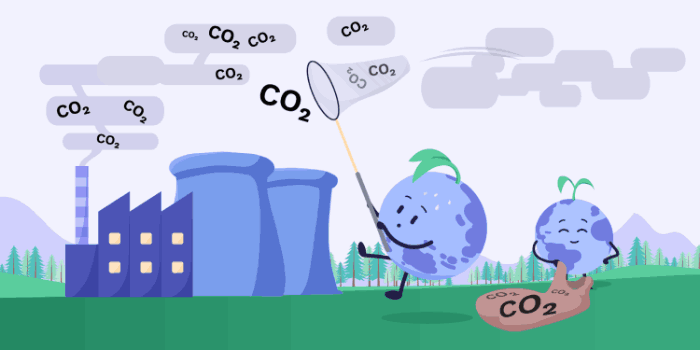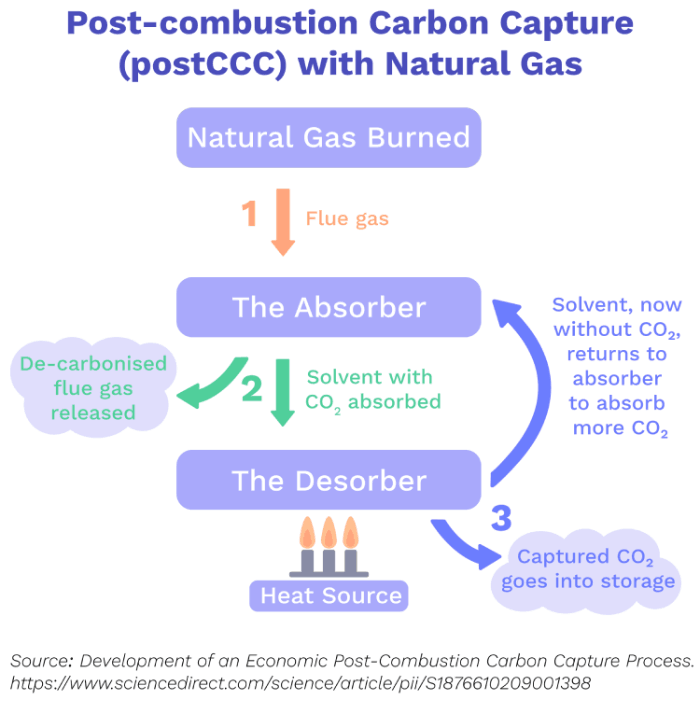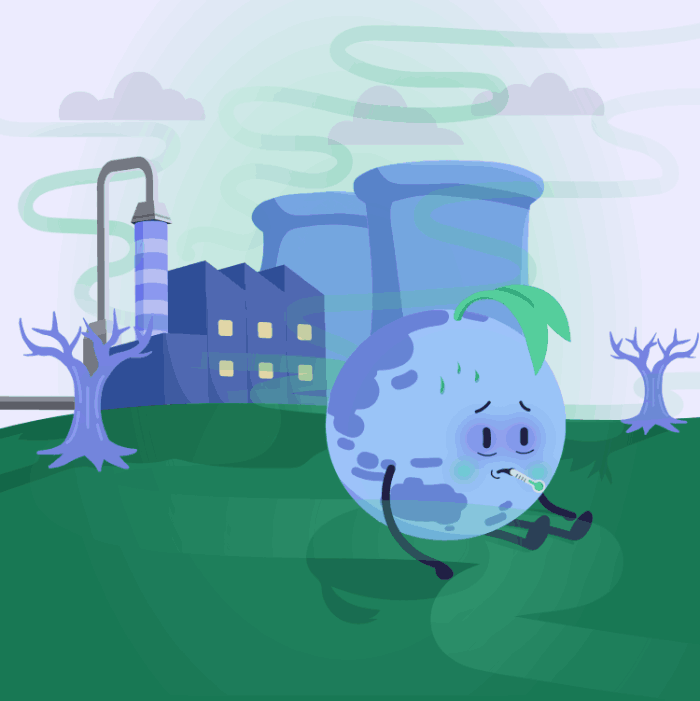PostCCC: Capturing CO₂ After We've Burnt it
8 minute read
Updated on: 14 Jul 2021

What is post-combustion CO₂ capture (postCCC)?
Once fossil fuels are burnt, exhaust gases, known as flue gas, are released into the atmosphere.
Around 5-15% of the volume of the flue gas is made up of CO₂ (depending on if it is a gas or coal power plant) . The postCCC process removes CO₂ from the flue gas before it is released into the atmosphere.
PostCCC can remove 89% of the CO₂ that would otherwise have been emitted ! In addition, unlike other carbon capture options, the existing power plants don’t need to be modified for this process to work
!
As separating and capturing CO₂ uses energy, it also releases emissions. This means we end up capturing more CO₂ than we actually avoid . Regardless, we still avoid lots of CO₂! The diagram below shows this idea, which applies to all of the carbon capture technologies you see in this course
.
So how does postCCC work?
Capturing the emitted CO₂ can be done in several ways, but absorption is the most common method and is the one we’ll look at in this chapter.

Simplified diagram of how postCCC works
Absorption with liquid solvents
Absorption is where molecules pass into, and are taken up by, some other substance . In this case, CO₂ is absorbed into a solvent and is trapped there.
There are both physical and chemical methods of absorption .
- Physical methods absorb CO₂ by attracting the molecules.
- Chemical methods absorb CO₂ through chemical reactions.
Physical method:
This method involves dissolving the flue gases into solvents (in an absorber - see image above) without needing any chemical reactions . The used solvent, now containing dissolved CO₂, is then drained away and can be reused by heating the solvent to release the concentrated CO₂
. The CO₂ can then, finally, be collected for safe storage
.
Physical absorption requires high concentrations and pressures of CO₂ in the flue gas. So, for lower concentrations chemical absorption is preferred .
Chemical method:
The first step is to remove impurities (such as oxides of nitrogen and sulfur (NOx and SOx)) from the flue gases .
The flue gases then enter the absorber where the CO₂ in the gas reacts with the solvents to form a soluble carbonate salt. The CO₂ has now been removed from the flue gases so the remaining flue gases can then be released into the atmosphere.
Next, CO₂ must be removed from the solvent by desorption, the opposite of absorption. The solvent containing absorbed CO₂ is heated in a desorber (see image above) to reverse the chemical reaction so that the CO₂ can be separated and collected to be put into storage . The solvent, now CO₂ free, is returned to the absorber so it can be reused and absorb more CO₂, just like in the physical method.
When the opposite conditions are present, chemical solvents are usually used - which is why chemical absorption tends to be preferred for postCCC .
How feasible is postCCC?
The systems needed to absorb and desorb CO₂, and transfer fluids between different stages, require more energy, therefore reducing the efficiency of the plant compared to one without carbon capture technologies (as we saw in preCCC) . As with other CCS technologies, this also means the cost of energy produced by the power plant will be higher
.
Any other issues?
Unfortunately, the use of chemical absorption in postCCC plants makes the human toxicity potential (the effect of toxic substances on the human environment ) of the plant three times higher than for a plant without chemical absorption
!
It also causes a 40% increase in the eutrophication potential (the release of polluting nutrients into water and soils ) and the acidification potential (the release of corrosive acids into water and soils
), relative to a plant without carbon capture technologies
.
Eutrophication is a problem caused by the release of nutrients, such as nitrates and phosphates, into water that encourage the growth of surface algae . This restricts the ability of other aquatic plants and animals to survive
.
These environmental impacts are a serious concern for postCCC and are considerably higher than the environmental impacts of preCCC and oxy-fuel power plants .

The human toxicity potential is three times higher for a plant with chemical absorption
Stage of technology
Currently, postCCC technology is commonly used in coal power plants and in certain industrial chemical production plants .
However, there are currently no commercial natural gas plants using postCCC technologies as it has yet to be proven feasible at scale .
What will postCCC be like in the future?
Technical improvements will be needed to reduce the costs and increase the energy efficiency of the CO₂ capture processes in order for the technology to be adopted more widely . One key challenge will be developing solvents that can be regenerated using minimal energy, as a lot of energy is needed to heat up the solvents again for the extraction of CO₂
.
The use of heat recovery steam generators will help reduce the energy requirements for the CO₂ capture process and will also help reduce the costs !
PreCCC and oxy-fuel (which you will read about in the next chapter) require more processes earlier on in the power plant system, so can not be retrofitted . Therefore, in the long-term, postCCC will continue to be relevant for industry applications, especially where it is not feasible to redesign entire processes to facilitate carbon capture
.


